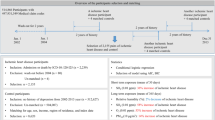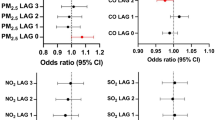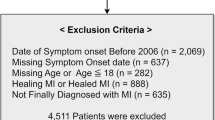Abstract
We previously observed increased odds of ST-elevation myocardial infarctions (STEMIs) associated with increased ambient fine particulate matter (PM2.5) in the previous hour. However, data are lacking on the effects of specific PM sources. Using data from 362 patients, a case–crossover design, and conditional logistic regression, we estimated the relative odds of STEMI associated with increased Delta-C (wood smoke), black carbon (BC; traffic), PM2.5, and gaseous pollutants in the previous 1–72 h. We did not observe increased odds of STEMIs associated with increased Delta-C or BC. We did observe increased odds associated with each 7.1 μg/m3 increase in PM2.5 (OR (95% CI): 1.17 (0.99, 1.39)) and each 19.9 p.p.b. increase in ozone (O3; 1.27 (1.00, 1.63)) in the previous hour, and each 0.22 p.p.m. increase in 48-h carbon monoxide (CO) concentrations (1.32 (1.00, 1.73]). Larger relative odds were associated with PM2.5 in May–October, and O3 and CO in November–April. Increased PM2.5, O3, and CO, but not wood smoke or BC, were associated with increased odds of STEMI, and effects may differ by season. Studies using spatially adjusted pollution estimates are needed, as well as studies further examining O3 and CO effects on the risk of STEMI.
This is a preview of subscription content, access via your institution
Access options
Subscribe to this journal
Receive 6 print issues and online access
$259.00 per year
only $43.17 per issue
Buy this article
- Purchase on Springer Link
- Instant access to full article PDF
Prices may be subject to local taxes which are calculated during checkout
Similar content being viewed by others
References
Lee BL, Kim B, Lee K . Air pollution and cardiovascular disease. Toxicol Res 2014; 30: 71–75.
Mustafic H, Jabre P, Caussin C, Murad MH, Escolano S, Tafflet M et al. Main air pollutants and myocardial infarction: a systematic review and meta-analysis. JAMA 2012; 307: 713–721.
Gardner B, Ling F, Hopke PK, Frampton MW, Utell MJ, Zareba W et al. Ambient fine particulate air pollution triggers ST-elevation myocardial infarction, but not non-ST elevation myocardial infarction: a case-crossover study. Part Fib Toxicol 2014; 11: 1.
Hoppin P, Jacobs M . Wood biomass for heat & power: addressing public health impacts – summary of a 2011 symposium. Available at www.sustainableproduction.org/WoodBiomass.php.
Hopke PK, Rossner A . Exposure to airborne particulate matter in the ambient, indoor, and occupational environments. Clin Occup Environ Med 2006; 5: 747–771.
United States Environmental Protection Agency. 2014. Fine particulate designations: frequent questions. Available http://www.epa.gov/pmdesignations/faq.htm. [Accessed on 25 January 2015].
Rohr AC, Wyzga RE . Attributing health effects to individual particulate matter constituents. Atmos Environ 2012; 62: 130–152.
Wyzga RE, Rohr AC . Long-term particulate matter exposure: attributing health effects to individual PM components. J Air Waste Manage 2015; 65: 523–543.
Lippmann M, Chen LC, Gordon T, Ito K, Thurston GD . National Particle Component Toxicity (NPACT) initiative: Integrated Epidemiologic and Toxicologic Studies of the Health Effects of Particulate Matter Components (Research Report 177). Health Effects Institute: Boston, MA. 2013.
Vedal S, Campen MJ, McDonald JD, Kaufman JD, Larson TV, Sampson PD et al. National Particle Component Toxicity (NPACT) Initiative Report on Cardiovascular Effects (Research Report 178). Health Effects Institute: Boston, MA. 2013.
Wang Y, Hopke PK, Rattigan OV, Chalupa DC, Utell MJ . Multiple-year black carbon measurements and source apportionment using delta-C in Rochester, New York. J Air Waste Manag Assoc 2012; 62: 880–887.
Wang Y, Hopke PK, Xia X, Rattigan OV, Chalupa DC, Utell MJ . Source apportionment of airborne particulate matter using inorganic and organic species as tracers. Atmos Environ 2012; 55: 525–532.
Naeher LP, Brauer M, Lipsett M, Zelikoff JT, Simpson CD, Koenig JQ et al. Woodsmoke health effects: a review. Inhal Toxicol 2007; 19: 67–106.
Barregard L, Sallsten G, Gustafson P, Andersson L, Johansson L, Basu S et al. Experimental exposure to wood-smoke particles in healthy humans: effects on markers of inflammation, coagulation, and lipid peroxidation. Inhal Toxicol 2006; 18: 845–853.
Swiston JR, Davidson W, Attridge S, Li GT, Brauer M, van Eeden SF . Wood smoke exposure induces a pulmonary and systemic inflammatory response in firefighters. Eur Respir J 2008; 32: 129–138.
Hejl AM, Adetona O, Diaz-Sanchez D, Carter JD, Commodore AA, Rathbun SL et al. Inflammatory Effects of woodsmoke exposure among wildland firefighters working at prescribed burns at the Savannah River Site, SC. J Occup Environ Hyg 2013; 10: 173–180.
Unosson J, Blomberg A, Sandstrom T, Muala A, Boman C, Nystrom R et al. Exposure to wood smoke increases arterial stiffness and decreases heart rate variability in humans. Part Fib Toxicol 2013; 10: 20.
Fairley D . Daily mortality and air pollution in Santa Clara County, California: 1989-1996. Environ Health Perspect 1999; 107: 637–641.
Sanhueza PA, Torreblanca MA, Diaz-Robles LA, Schiappacasse LN, Silva MP, Astete TD . Particulate air pollution and health effects for cardiovascular and respiratory causes in Temuco, Chile: a wood-smoke-polluted urban area. J Air Waste Manag Assoc 2009; 59: 1481–1488.
McCracken JP, Smith KR, Diaz A, Mittleman MA, Schwartz J . Chimney stove intervention to reduce long-term wood smoke exposure lowers blood pressure among Guatemalan women. Environ Health Perspect 2007; 115: 996–1001.
McCracken J, Smith KR, Stone P, Diaz A, Arana B, Schwartz J . Intervention to lower household wood smoke exposure in Guatemala reduces ST-segment depression on electrocardiograms. Environ Health Perspect 2011; 119: 1562–1568.
Johnston FH, Hanigan IC, Henderson SB, Morgan GG . Evaluation of interventions to reduce air pollution from biomass smoke on mortality in Launceston, Australia: retrospective analysis of daily mortality, 1994-2007. BMJ 2013; 346: e8446.
O’Gara PT, Kushner FG, Ascheim DD, Casey DE, Chung MK, de Lemos JA et al. ACCF/AHA guideline for the management of ST-elevation myocardial infarction: a report of the American College of Cardiology Foundation/American Heart Association Task Force on Practice Guidelines. Circulation 2013; 127: e362–e425.
Hansen ADA, Rosen H, Novakov T . The Aethalometer - An instrument for the real-time measurement of optical absorption by aerosol particles. Sci Total Environ 1984; 36: 191–196.
Wang Y, Hopke PK, Rattigan OV, Xia X, Chalupa DC, Utell MJ . Characterization of residential wood combustion particles using the two-wavelength aethalometer. Environ Sci Technol 2011; 45: 7387–7393.
Simoneit BRT, Schauer JJ, Nolte CG, Oros DR, Elias VO, Fraser MP et al. Levoglucosan, a tracer for cellulose in biomass burning and atmospheric particles. Atmos Environ 1999; 33: 173–182.
Simoneit BT . Biomass burning - a review of organic tracers for smoke from incomplete combustion. Appl Geochem 2002; 17: 129–162.
Levy D, Lumley T, Sheppard L, Kaufman J, Checkoway H . Referent selection in case-crossover analyses of acute health effects of air pollution. Epidemiology 2001; 12: 186–192.
Maclure M . The case-crossover design: a method for studying transient effects on the risk of acute events. Am J Epidemiol 1991; 133: 144–153.
Levy D, Sheppard L, Checkoway H, Kaufman J, Lumley T, Koenig J et al. A case-crossover analysis of particulate matter air pollution and out-of-hospital primary cardiac arrest. Epidemiology 2001; 12: 193–199.
Sullivan J, Sheppard L, Schreuder A, Ishikawa N, Siscovick D, Kaufman J . Relation between short-term fine-particulate matter exposure and onset of myocardial infarction. Epidemiology 2005; 16: 41–48.
Zanobetti A, Schwartz J . The effect of particulate air pollution on emergency admissions for myocardial infarction: a multicity case-crossover analysis. Environ Health Perspect 2005; 113: 978–982.
Pope CA, Muhlestein JB, May HT, Renlund DG, Anderson JL, Horne BD . Ischemic heart disease events triggered by short-term exposure to fine particulate air pollution. Circulation 2006; 114: 2443–2448.
Rich DQ, Kipen HM, Zhang J, Kamat L, Wilson AC, Kostis JB . Triggering of transmural infarctions, but not nontransmural infarctions, by ambient fine particles. Environ Health Perspect 2010; 118: 1229–1234.
Hanigan IC, Johnston FH, Morgan GG . Vegetation fire smoke, indigenous status and cardio-respiratory hospital admissions in Darwin, Australia, 1996-2005: a time-series study. Environ Health 2008; 7: 42.
Delfino RJ, Brummel S, Wu J, Stern H, Ostro B, Lipsett M et al. The relationship of respiratory and cardiovascular hospital admissions to the southern California wildfires of 2003. Occup Environ Med 2009; 66: 189–197.
Henderson SB, Brauer M, MacNab YC, Kennedy SM . Three measures of forest fire smoke exposure and their associations with respiratory and cardiovascular health outcomes in a population-based cohort. Environ Health Perspect 2011; 119: 1266–1271.
Dockery DW, Luttmann-Gibson H, Rich DQ, Link MS, Mittleman MA, Gold DR et al. Association of air pollution with increased incidence of ventricular tachyarrythmias recorded by implanted cardioverter defibrillators. Environ Health Perspect 2005; 113: 670–674.
Zanobetti A, Schwartz J . Air pollution and emergency admissions in Boston, MA. J Epidemiol Commun H 2006; 60: 890–895.
Zanobetti A, Gold DR, Stone PH, Suh HH, Schwartz J, Coull BA et al. Reduction in heart rate variability with traffic and air pollution in patients with coronary artery disease. Environ Health Perspect 2010; 118: 324–330.
Gryparis A, Coull BA, Schwartz J, Suh HH . Semiparametric latent variable regression models for spatiotemporal modelling of mobile source particles in the greater Boston area. J R Stat Soc Ser C Appl Stat 2007; 56: 183–209.
Bell ML, Dominici F, Samet JM . A meta-analysis of time-series studies of ozone and mortality with comparison to the National Morbidity, Mortality, and Air Pollution Study. Epidemiology 2005; 16: 436–445.
Nuvolone D, Blazi D, Pepe P, Chini M, Scala D, Giovannini F et al. Ozone short-term exposure and acute coronary events: a multicities study in Tuscany (Italy). Environ Res 2013; 126: 17–23.
Gryparis A, Forsberg B, Katsouyanni K, Analitis A, Touloumi G, Schwartz J et al. Acute effects of ozone on mortality from the “Air Pollution and Health: A European Approach” Project. Am J Respir Crit Care Med 2004; 170: 1080–1087.
United States Environmental Protection Agency, 2014. Ground level ozone. Available http://www.epa.gov/groundlevelozone/ [accessed on 29 January 2015].
Safieddine S, Clerbaux C, George M, Hadji-Lazaro J, Hurtmans D, Coheur PF et al. Tropospheric ozone and nitrogen dioxide measurements in urban and rural regions as seen by IASI and GOME-2. J Geophys Res Atmos. 2013; 118: 10,555–10,566.
Mittleman MA, Siscovick DS . Physical exertion as a trigger of myocardial infarction and sudden cardiac death. Cardiol Clin 1996; 14: 263–270.
Thompson PD, Franklin BA, Balady GJ, Blair SN, Corrado D, Estes M et al. Exercise and acute cardiovascular events-placing the risks into perspective: a scientific statement from the American Heart Association Council on Nutrition, Physical Activity, and Metabolism and the Council on Clinical Cardiology. Circulation 2007; 115: 2358–2368.
von Klot S, Mittleman MA, Dockery DW, Heier M, Meisinger C, Hormann A et al. Intensity of physical exertion and triggering of myocardial infarction: a case-crossover study. Eur Heart J 2008; 29: 1881–1888.
Chuang K, Chan C, Su T, Lee C, Tang C . The effect of urban air pollution on inflammation, oxidative stress, coagulation, and autonomic dysfunction in young adults. Am J. Crit Care Med 2007; 176: 370–376.
United States Environmental Protection Agency. Integrated Science Assessment for Particulate Matter Research Triangle Park, NC 2009.
Brook RD, Rajagopalan S, Pope CA, Brook JR, Bhatnagar A, Diez-Roux AV et al. Particulate matter air pollution and cardiovascular disease: an update to the scientific statement from the American Heart Association. Circulation 2010; 121: 2331–2378.
Stewart JC, Chalupa DC, Devlin RB, Frasier LM, Huang LS, Little EL et al. Vascular effects of ultrafine particles in persons with type 2 diabetes. Environ Health Perspect 2010; 118: 1692–1698.
Bind MA, Baccarelli A, Zanobetti A, Tarantini L, Suh H, Vokonas P et al. Air pollution and markers of coagulation, inflammation, and endothelial function: associations and epigene-environment interactions in an elderly cohort. Epidemiology 2012; 23: 332–340.
Rich DQ, Kipen HM, Huang W, Wang G, Wang Y, Zhu P et al. Association between changes in air pollution levels during the Beijing Olympics and biomarkers of inflammation and thrombosis in healthy young adults. JAMA 2012; 307: 2068–2078.
Rich DQ, Zareba W, Beckett W, Hopke PK, Oakes D, Frampton MW et al. Are ambient ultrafine, accumulation mode, and fine particles associated with adverse cardiac responses in patients undergoing cardiac rehabilitation? Environ Health Perspect 2012; 120: 1162–1169.
Wang Y, Hopke PK, Utell MJ . Urban-scale spatial-temporal variability of black carbon and winter residential combustion particles. Aerosol Air Quality Res 2011; 5: 473–481.
Acknowledgements
This study was funded by grants from the National Heart, Lung, and Blood Institute (grant #5T32HL007937), the New York State Energy Research and Development Authority (contract #32971), and the National Institutes of Environmental Health Sciences (grant #P30 ES001247).
Author information
Authors and Affiliations
Corresponding author
Ethics declarations
Competing interests
The authors declare no conflict of interest.
Rights and permissions
About this article
Cite this article
Evans, K., Hopke, P., Utell, M. et al. Triggering of ST-elevation myocardial infarction by ambient wood smoke and other particulate and gaseous pollutants. J Expo Sci Environ Epidemiol 27, 198–206 (2017). https://doi.org/10.1038/jes.2016.15
Received:
Accepted:
Published:
Issue Date:
DOI: https://doi.org/10.1038/jes.2016.15
Keywords
This article is cited by
-
Cardiovascular health impacts of wildfire smoke exposure
Particle and Fibre Toxicology (2021)
-
Systematic review and meta-analysis of case-crossover and time-series studies of short term outdoor nitrogen dioxide exposure and ischemic heart disease morbidity
Environmental Health (2020)
-
Weather effects on hand, foot, and mouth disease at individual level: a case-crossover study
BMC Infectious Diseases (2019)
-
Changes in triggering of ST-elevation myocardial infarction by particulate air pollution in Monroe County, New York over time: a case-crossover study
Environmental Health (2019)
-
Daily land use regression estimated woodsmoke and traffic pollution concentrations and the triggering of ST-elevation myocardial infarction: a case-crossover study
Air Quality, Atmosphere & Health (2018)



